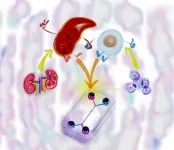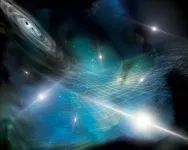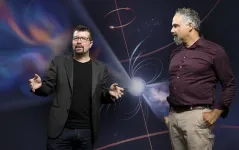(Press-News.org) Kyoto, Japan -- Animal experimentation may not be a thing of the past just yet, but work on human iPS cell technology may someday grant emancipation for lab mice and other species.
Renal proximal tubules are an essential part of our kidneys' ability to reabsorb vital substances into the bloodstream, such as albumin, before the conversion to urine.
However, in order to pursue accurate testing and other applications, researchers have needed a quantitative evaluation system that simulates the function of these tubules; existing methods could only evaluate epithelial cells using animal experiments and cultures.
A team of researchers from Kyoto University has now developed a model microchip using human iPS cells to measure the transport capacity of the membrane proteins and potentially give test animals some respite.
"We focused on the fact that human iPSC-derived organoids contain highly functional cells whose functions are enhanced when cultured on a microfluidic device," explains lead author Ramin Banan Sadeghian of KyotoU's Graduate School of Engineering.
This microphysiological system -- or MPS -- is designed to reproduce the mechanisms of glucose reabsorption and drug excretion in the renal proximal tubules in vitro and ex vivo, mimicking human epithelial cells.
"We found that glucose uptake and transport are at significantly higher rates through the engineered co-culture tissue than through monocultures," says Toshikazu Araoka of KyotoU's Center for iPS Cell Research and Application, CiRA, referring to the team's use of a blend of pluripotent cell-derived and immortalized proximal tubule epithelial cells.
"Our results also showed that shear stress stimulation of the two cell types increased the transport capacities of the membrane proteins SGLT-2 and P-gp," adds team leader Minoru Takasato at RIKEN Center for Frontier Biosciences.
Team leader Takashi Yokokawa's team anticipates applying their MPS model as a screening tool for newly developed drugs by evaluating the transport and nephrotoxicity of various membrane proteins.
For example, these methods may enable patient-specific disease modeling, drug screening, and pathogenesis study by incorporating patient-derived stem cells into the required organoids.
"Our model will enable us to obtain the diseased cells that can be co-cultured with existing cell lines to form a homogenous tissue for analysis and treatment purposes," notes Yokokawa.
###
The paper "Cells sorted off hiPSC-derived kidney organoids coupled with immortalized cells reliably model the proximal tubule" appeared on 4 May 2023 in Communications Biology, with doi: 10.1038/s42003-023-04862-7
About Kyoto University
Kyoto University is one of Japan and Asia's premier research institutions, founded in 1897 and responsible for producing numerous Nobel laureates and winners of other prestigious international prizes. A broad curriculum across the arts and sciences at undergraduate and graduate levels complements several research centers, facilities, and offices around Japan and the world. For more information, please see: http://www.kyoto-u.ac.jp/en
END
Test animals, hold your breath
Human iPSCs at the heart of renal model chip development
2023-06-29
ELSE PRESS RELEASES FROM THIS DATE:
BBCube 3D: a breakthrough in semiconductor integration and data transmission
2023-06-29
A technology for the three-dimensional integration of processing units and memory, as reported by researchers from Tokyo Tech, has achieved the highest attainable performance in the whole world, paving the way to faster and more efficient computing. Named "BBCube 3D," this innovative stacked architecture achieves higher data bandwidths than state-of-the-art memory technologies, while also minimizing the energy needed for bit access.
In the present digital age, engineers and researchers keep coming up with new computer-assisted technologies that require higher data bandwidths between the processing units (or PUs, such as GPUs and CPUs) and memory chips. Some examples ...
Scientists find evidence for slow-rolling sea of gravitational waves
2023-06-29
Scientists are reporting the first evidence that our Earth and the universe around us are awash in a background of spacetime undulations called gravitational waves. The waves oscillate very slowly over years and even decades and are thought to originate primarily from pairs of supermassive black holes leisurely spiraling together before they merge.
The findings, reported in a series of papers in The Astrophysical Journal Letters, come from 15 years’ worth of observations made ...
First misinformation susceptibility test finds ‘very online’ Gen Z and millennials are most vulnerable to fake news
2023-06-29
University of Cambridge psychologists have developed the first validated “misinformation susceptibility test”: a quick two-minute quiz that gives a solid indication of how vulnerable a person is to being duped by the kind of fabricated news that floods online spaces.
The test, proven to work through a series of experiments involving over 8,000 participants taking place over two years, has been deployed by polling organisation YouGov to determine how susceptible Americans are to fake headlines.
The first survey to use the new 20-point test, called ‘MIST’ ...
Clamor of gravitational waves from universe’s merging supermassive black holes ‘heard’ for first time
2023-06-29
Following 15 years of data collection in a galaxy-sized experiment, scientists have “heard” the perpetual chorus of gravitational waves rippling through our universe for the first time — and it’s louder than expected.
The groundbreaking discovery was made by scientists with the North American Nanohertz Observatory for Gravitational Waves (NANOGrav) who closely observed stars called pulsars that act as celestial metronomes. The newly detected gravitational waves — ripples in the fabric of space-time — are by far the most powerful ever measured: They carry roughly a million times as much energy as ...
Gravitational waves from colossal black holes found using 'cosmic clocks'
2023-06-29
You can't see or feel it, but everything around you — including your own body — is slowly shrinking and expanding. It's the weird, spacetime-warping effect of gravitational waves passing through our galaxy, according to a new study by a team of researchers with the U.S. National Science Foundation's NANOGrav Physics Frontiers Center.
The findings published today in The Astrophysical Journal Letters are from the North American Nanohertz Observatory for Gravitational Waves (NANOGrav), a collaborative team of researchers from more than 50 institutions in the U.S. and abroad. The team ...
Scientists use exotic stars to tune into hum from cosmic symphony
2023-06-29
Astrophysicists using large radio telescopes to observe a collection of cosmic clocks in our Galaxy have found evidence for gravitational waves that oscillate with periods of years to decades, according to a set of papers published today in The Astrophysical Journal Letters. The gravitational-wave signal was observed in 15 years of data acquired by the North American Nanohertz Observatory for Gravitational Waves (NANOGrav) Physics Frontiers Center (PFC), a collaboration of more than 190 scientists from the US and Canada who use pulsars ...
Australian astronomers find possible ‘fingerprints’ of gravitational waves
2023-06-29
Astronomers using data collected by CSIRO’s Parkes radio telescope, Murriyang, have found their strongest evidence yet for low-frequency gravitational waves.
For nearly 20 years the Parkes Pulsar Timing Array collaboration has monitored a set of rapidly spinning stars that pulse like a lighthouse, called pulsars.
They are looking for nanosecond pulse delays caused by gravitational waves to provide further evidence for Einstein’s general theory of relativity and build on our understanding of the Universe.
By ...
Astrophysics collaboration led by Oregon State finds ‘chorus’ of gravitational waves
2023-06-29
CORVALLIS, Ore. – Gravitational waves, ripples in the fabric of time-space predicted by Albert Einstein more than a century ago, are permeating the universe at low frequencies, according to a multiyear National Science Foundation project led by Oregon State University scientists.
The findings appear in a collection of five papers authored by researchers from the NANOGrav Physics Frontier Center co-directed by Xavier Siemens, professor of physics in the OSU College of Science.
Evidence of the gravitational waves, whose oscillations are ...
CCNY professor Jacek Dmochowski breaks down science of sports betting
2023-06-29
It’s a dilemma that many a regular bettor probably faces often -- deciding when to place a sports bet. In a study entitled “A statistical theory of optimal decision-making in sports betting,” Jacek Dmochowski, Associate Professor in the Grove School of Engineering at The City College of New York, provides the answer. His original finding appears in the journal PLOS One.
“The central finding of the work is that the objective in sports betting is to estimate the median outcome. Importantly, this is not the same as the average outcome,” said Dmochowski, whose expertise ...
Menopausal hormone therapy linked to increased rate of dementia
2023-06-29
Use of menopausal hormone therapy is associated with an increased rate of dementia and Alzheimer’s disease, suggests a large Danish study published by The BMJ today.
An increase was seen in long term users of menopausal hormone therapy, but also in short term users around the age of menopause (55 years or younger) as is currently recommended.
These findings align with the largest clinical trial carried out on this topic, and the researchers call for further studies “to explore if the observed association in this study between menopausal hormone therapy use and increased risk of dementia illustrates a causal ...
LAST 30 PRESS RELEASES:
Ants: An untapped resource in the development of antibiotics?
Archaeologists use AI to create prehistoric video game
Mitochondria migrate toward the cell membrane in response to high glucose levels
Tiny viral switch offers hope against drug-resistant bacteria
Most parents aware of early peanut introduction guidelines, but confused about details
HPV vaccine can protect against severe lesions of the vulva and vagina
Virtual care provision and emergency department use among children and youth
Quadrivalent HPV vaccine and high-grade vulvovaginal lesions
Insights into dry eyes gained from stem cell-derived tear glands
Researchers identify 166 human pluripotent stem cell lines available for use in clinical applications
Europa Clipper instrument uniquely observed interstellar comet 3I/ATLAS
UN University Report challenges climate change as sole trigger of Syrian Civil War, exposing governance failures in drought response
Real estate investment trust (REIT) acquisition associated with hospital closure and bankruptcy
New Raman imaging system detects subtle tumor signals
Boston Children’s receives a $7.5 million grant from Aligning Research to Impact Autism (ARIA) to provide clinical research coordination for the IMPACT Network
Spray-on antibacterial coating offers new protection for plants against disease and drought
ESMT Berlin study: What makes a first offer successful in negotiations
Groundbreaking ceremony marks the beginning of CTAO-South Array construction in Chile
Why swearing makes you stronger
What prevents more cancer patients from enrolling in potentially life-saving clinical trials?
UK’s worst-case climate risks laid bare for lawmakers
A decline in churchgoing linked to more deaths of despair
TAMEST announces Maralice Conacci-Sorrell, Ph.D., UT Southwestern Medical Center, as 2026 Mary Beth Maddox Award & Lectureship Recipient
Global study to evaluate whether dengue outbreaks can be anticipated earlier
Chonnam National University researchers propose innovative voltage-loop control for power factor correction
Accelerating next-generation drug discovery with click-based construction of PROTACs
Detecting the hidden magnetism of altermagnets
$7M gift supports health research, engineering and athletics at UT San Antonio
NU-9 halts Alzheimer’s disease in animal model before symptoms begin
Hospitals acquired by real estate investment trusts associated with greater risk of bankruptcy, closure
[Press-News.org] Test animals, hold your breathHuman iPSCs at the heart of renal model chip development





